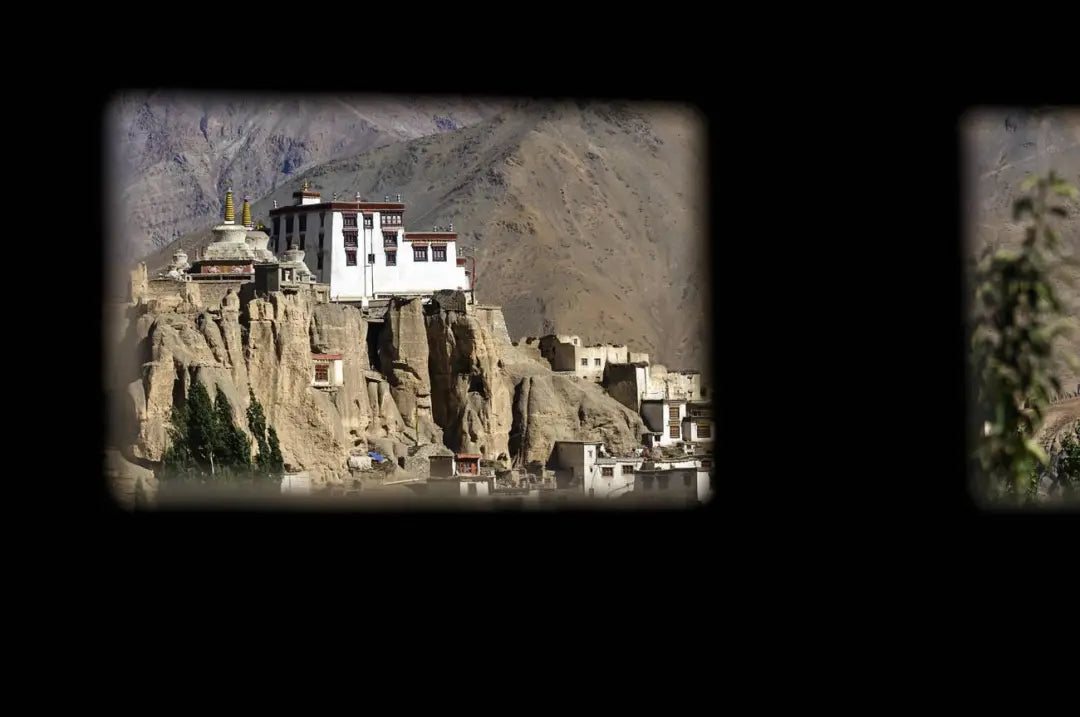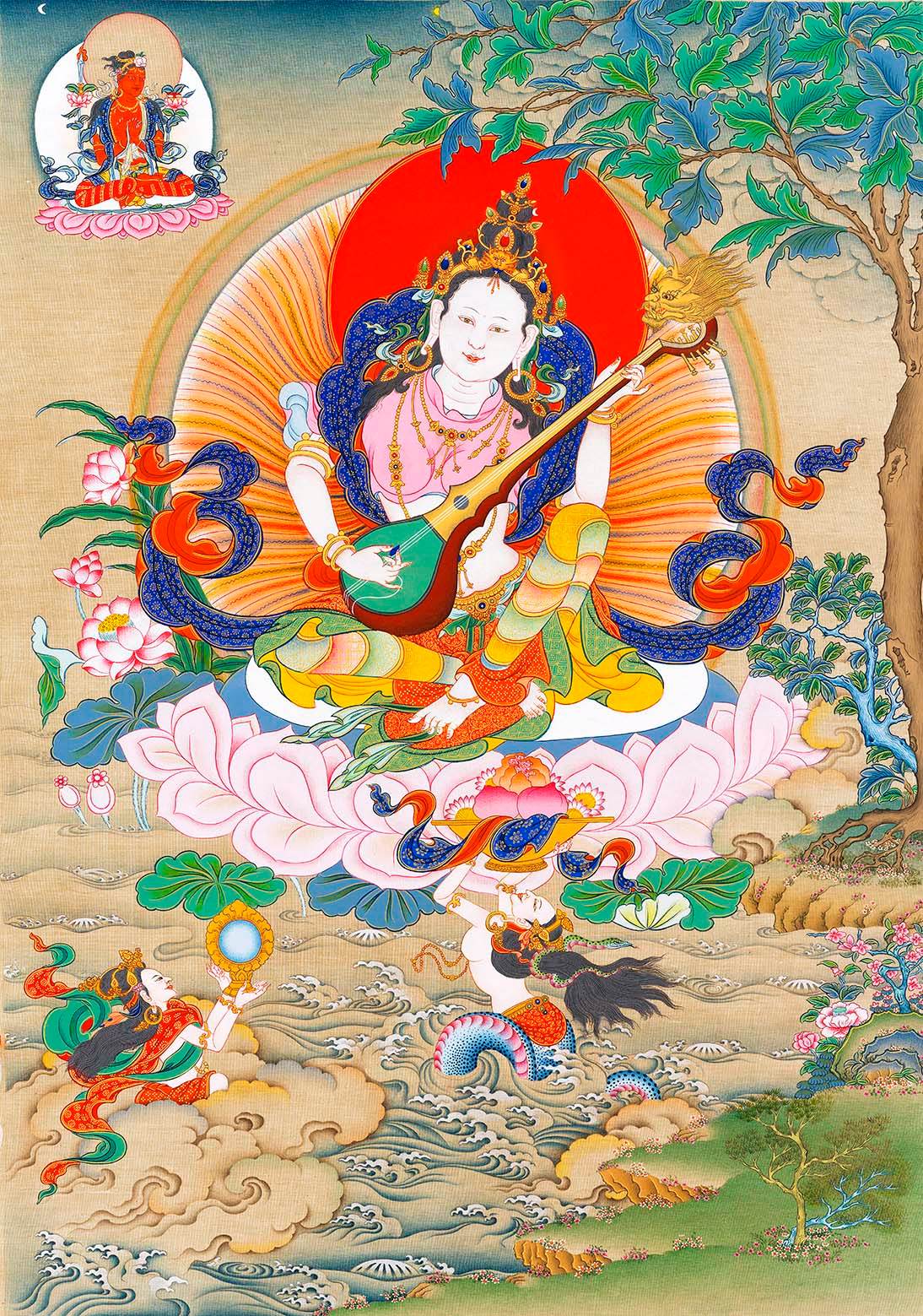
"Storytelling" Tibetan Windows

Window to Tibet
Photo: Pinterest
Aesthetic Utopia
German art critic Peter Herbstreuth, in his analysis of the Himalayan architectural sketches by Robert Powell (an Australian architect and painter who devoted his life to Himalayan culture and documented local architectural artistry through hand-drawn notes during his travels and work in the region), described his impression of Himalayan architecture as follows:
"The inhabitants of these high-altitude regions transform protections against the fluctuations of nature into ornamentation. It is a feast of forms—sometimes also of colors... Their methods of construction, embellishments, and sense of decoration strike the viewer with such intensity, like experiencing an aesthetic utopia through a surrealist variation. The exquisitely carved windows stand like pedestal-less sculptures: sturdy, rich in detail, and sharply defined."
The creative use of color is one of the defining features of Tibetan window ornamentation. Interwoven and blended hues serve not only as decoration but also carry profound religious meanings—blessings, prayers, reverence, offerings, and more. The intricate hand-painted patterns are never arbitrary doodles; they subtly convey deep, mysterious, gentle, or auspicious messages and emotions.
The transformation and elevation from functionality to artistry reflect the wisdom of highland inhabitants, who respond to the weight of their harsh environment with spiritual resilience—breathing in harmony with nature, guided by reverence and humility. Over millennia, this cultural legacy has evolved into a unique visual language.
Windows, Eyes
People always seem to instinctively associate windows with eyes, regarding windows as the "eyes" of a house. If we compare the human body to a dwelling that carries the soul, the eyes are likewise seen as the windows of this dwelling. Through windows, one sees the scenery outside; through clear and pure eyes, the world is reflected in the human soul. As a "passage" or "tool" for seeing, both windows and eyes share the same quality—they connect the inner and outer spaces.
As an essential part of architecture, a window serves the functions of lighting and ventilation. It also acts as an "interface" for viewing the outside world—a meeting point between interior and exterior. Particularly in Tibetan culture, windows often become a crucial link between the secular and the sacred.
The harsh natural conditions of the plateau demand that its architecture possess exceptional protective qualities. For instance, the black trapezoidal "Barka" painted around window frames—a distinctive feature of Tibetan window ornamentation—is often explained physically as a practical measure to absorb heat and ward off cold. Spiritually, however, this unique design is regarded as a symbol of warding off evil and purification.
As German architect Nils Gutschow observed about the use of color in Himalayan architecture: "These colors are not meant to protect the material surface of the building but to shield its inhabitants from malevolent forces that seek to assault the house."This highly creative approach, he noted, "reflects the wildness of the landscape."
The emphasis placed on windows reflects the reverence highland dwellers hold for this channel of observation. It also carries a metaphor: the devout yearning of the physically limited human body to glimpse the vast external world (or the inner spiritual realm) through these openings.
Thus, the people of the plateau condense their contemplations and emotions—toward family, nature, and the divine—into the diverse forms of window frames. Whether driven by practical needs or spiritual beliefs, these expressions manifest through exquisite carvings or vibrant, sacred paintings. In a solemn artistic ritual, form and spirit achieve perfect harmony, creating a visual feast of shapes and colors.
Creation as Devotion
Recognizing "faces" in imagery seems to be an innate human instinct. Upon careful observation of a Tibetan-style building, one might momentarily perceive the structure as resembling a face.
The windows resemble deep-set eyes, with the black-framed "Barka" casting shadows like eyelashes under the intense plateau sunlight, exuding an air of mystery. The vibrant, multicolored paintings perfectly convey a spectrum of emotions, even reflecting the inner spiritual world. When a gentle breeze passes, the fluttering "shambu" fabric transforms into undulating waves, as if responding with sentient grace to the emotions of those who pause to gaze. In this moment, stillness and motion intertwine in a wondrous syntax, transmitting ineffable beauty directly to the human heart.
This form of interaction transcends language, becoming a wordless meeting of minds. The architecture seems imbued with personality and spirituality. Yet such aesthetic transcendence, rooted in folk tradition, often stems not from unattainable masterpieces but from unnamed local artisans' devotion.
In modern architectural discourse, design tends to be a priori—born from flawless blueprints. In Tibet, however, construction and ornamentation frequently emerge through lived experience. Beauty here seldom springs from academic planning, but rather from intergenerational craftsmanship. It blossoms organically through near-instinctive mastery, where technique becomes muscle memory. This irreplaceable beauty is ultimately born of wisdom, insight, and reverence.
If this too is a form of artistic pursuit, then these craftsmen seek not self-expression or worldly fame, but creation as pure devotion. Through their hands, the act of making becomes an offering. This egoless yet wholehearted artistry imbues their work with tranquil, enduring power—allowing it to transcend time and space.
Presence, Contemplation
In an interview, Powell described his impression of Himalayan architecture: "What we see today must have existed three thousand years ago. In any traditional building, you can perceive the passage of time. Even if the structure is well-preserved, you still sense time slipping away. I’ve always found this utterly captivating... To me, a building that fails to convey a sense of time also lacks presence."
Bearing the marks of time, inheriting accumulated craftsmanship, reflecting aesthetic evolution, and embodying spiritual devotion—these structures on the plateau hold dual codes of time and culture within their depths. They are never mere emotionless piles of material or soulless surface adornments.
It is the passage of epochs, the interplay between people and architecture, that breathes life and soul into them. Thus, every detail of an aged building tells a story. These codes await the moment when generation after generation passes by, finally encountering and gazing upon them, sparking a wordless dialogue of understanding. Only then can one perceive the interweaving of time and space, the tension between past and present, in all its rich and intricate dimensions.

A furniture market in Lhasa during the 1980s-90s
The flower-filled windows of adjacent buildings draw attention
Photo: Pinterest
The unshakable and undeniable "presence" of architecture lies precisely in its enduring use, experience, and perception over the long river of time—maintaining a silent rhythm synchronized with human activity. This profound relationship, sustained through inheritance, does not decay with the passage of years. A modern urban structure devoid of such traces could never compare.
The sense of presence in architecture, in fact, also forms the premise of a certain "contemplative quality" in architectural aesthetics—that is, architecture serves as both the medium through which humans exist in this world (by creating inhabitable spaces on the earth) and, through elements like space, light, materials, and structure, guides and inspires human perception and understanding of their own existence and the world. A building is, in essence, a microcosm.
In Eastern philosophy, "contemplation" represents a mode of introspection and enlightenment. It is not a rigid, obsessive fixation on an object, but rather an alert observation and experience that awakens awareness of one's own mind and nature. Through the act of contemplation, the subject and the object achieve a mutual spiritual reflection.

A woman gazes out the window in Kathmandu
Photo: Pinterest
Thus we return to the "presence" and "contemplative quality" in Tibetan architectural aesthetics. Often, these structures exist not merely for functional purposes, nor solely to showcase external beauty. Their profound designs and ornaments also serve as visual conduits, subtly reflecting the perpetual interplay and resonance between humans, nature, and the divine.

A woman smiles by the window in a Himalayan village
Photo: Pinterest
As German philosopher Heidegger articulated in his essay on building, dwelling, and thinking: "Architecture is not merely a shelter, but a mode of poetic dwelling." He emphasized that architecture is inseparable from human existence on earth and our relationship with the world—true "dwelling" is a profound connection with being. It is this unreserved mutual inspiration and interdependence between people and structures that constitutes the poetry of such habitation.

An elderly man rests by the window in a Himalayan village
Photo: Pinterest
Living Space, Beautiful Soul
Open a window and gaze into the distance. Shadows of clouds and light interweave, prayer flags dance like waves in the wind. One stands at the window admiring the view—while perhaps, far away, a traveler passes by, making them part of each other's scenery.
Prayer wheels creak as they turn, occasionally joined by the cheerful "ding" of rooftop bells, while murmured chants drift through windows—all these notes merge into the wind, becoming nature's harmony. At this moment, no one can claim a building is merely a static, emotionless presence. It is undeniably a living space, perpetually breathing, pulsing, and interacting intimately with people.
Bearing the past while thriving in the present. When you pause to admire these uniquely beautiful window arts, take a moment to truly feel their "vital presence" and decipher the stories and mysteries they hold. Only then can you wordlessly touch the soul of Tibetan architectural beauty.







1 commento
oqzua4